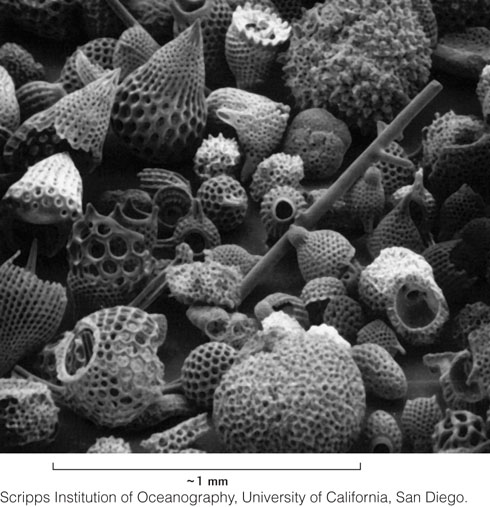Ocean Sedimentation
Almost everywhere oceanographers search the seafloor, they find a thick blanket of sediments. The ceaseless sedimentation in the world ocean modifies the structures formed by plate tectonic processes and creates its own topography at sites of rapid deposition. The sediments are mainly of two kinds: terrigenous muds and sands eroded from the continents, and biologically precipitated shells and skeletons of marine organisms. In regions of the ocean near subduction zones, sediments derived from volcanic ash and lava flows are abundant. In tropical arms of the sea where evaporation is intense, evaporite sediments are deposited.
579
Sedimentation on the Continental Shelf
Waves and tides are responsible for terrigenous sedimentation on the continental shelf. The waves produced by intense storms move sediments over the shallow and moderate depths of the shelf, and tidal currents flow over the shelf. These waves and currents distribute the sediments brought in by rivers and eroded at the shoreline into long ribbons of sand and layers of silt and mud. Turbidity currents carry these sediments over the edge of the shelf into the deep sea.
Biological sedimentation on the shelf results from the buildup of the calcium carbonate shells and skeletons of organisms living in shallow waters. Most of these organisms cannot tolerate muddy waters and are found only where terrigenous materials are scarce or absent, such as along the extreme southern coast of Florida or off the coast of the Yucatán Peninsula in Mexico. Here, coral reefs thrive and organisms build up large thicknesses of carbonate sediments (see Chapter 5).
Deep-Sea Sedimentation
Far from the margins of continents, fine-grained terrigenous and biologically precipitated particles suspended in seawater slowly settle from the surface to the bottom. These open-ocean sediments, called pelagic sediments, are characterized by their great distance from continental margins, their fine particle size, and their slow-settling mode of deposition. The terrigenous materials are mainly clays, which accumulate on the seafloor at a very slow rate—a few millimeters every 1000 years. A small fraction, about 10 percent, may be blown by winds to the open ocean.
The most abundant biologically precipitated pelagic sediments are the shells of foraminifera. These tiny single-celled animals float in the surface waters of the oceans, and their calcium carbonate shells fall to the bottom after the occupants die. There they accumulate as foraminiferal oozes, sandy and silty sediments composed of foraminiferal shells (Figure 20.26). Other carbonate oozes are made up of different types of carbonate shells, called coccoliths.

Foraminiferal and other carbonate oozes are abundant at depths of less than about 4 km, but they are rare on the deeper parts of the seafloor. This rarity cannot result from a lack of shells, because the surface waters are full of foraminifera everywhere, and the living organisms are unaffected by processes at the bottom far below. The explanation for the absence of carbonate oozes on the deep seafloor is that the shells dissolve below a certain depth, called the carbonate compensation depth (Figure 20.27). Because of thermohaline circulation, deeper waters differ from shallower waters in three ways:
580
- 1. Deeper waters are colder. Colder, denser polar waters sink beneath warmer tropical waters and travel toward the equator along the ocean bottom.
- 2. Deeper waters contain more carbon dioxide. Not only do colder waters absorb more CO2 than warmer waters, but any organic matter they carry tends to be oxidized to CO2 in the course of their long circulation.
- 3. Deeper waters are under higher pressure due to the greater weight of overlying water.

These three factors make calcium carbonate more soluble in deep waters than in shallow ones. As the shells of dead foraminifera fall below the carbonate compensation depth, they enter an environment undersaturated with calcium carbonate, and they dissolve.
Another kind of biologically precipitated sediment, siliceous ooze, is produced by sedimentation of the silica shells of diatoms (a type of green algae) and radiolarians (single-celled protists). Both types of planktonic organisms are abundant in ocean surface waters. After burial on the seafloor, siliceous oozes are cemented into the siliceous rock chert.
581
Some components of pelagic sediments form by chemical reactions of seawater with sediments on the seafloor. The most prominent examples are manganese nodules: black, lumpy accumulations ranging from a few millimeters to many centimeters across. These nodules cover large areas of the deep seafloor—as much as 20 to 50 percent in the Pacific Ocean basin. Rich in nickel and other metals, they are a potential commercial resource if some economical way can be found to mine them and if legal issues regarding their ownership can be resolved. In 1982, the United Nations adopted an agreement known as the Convention on the Law of the Sea, which governs the territorial and economic rights of nations in the world’s oceans. At the time of this writing, however, the United States has not signed the agreement.
582